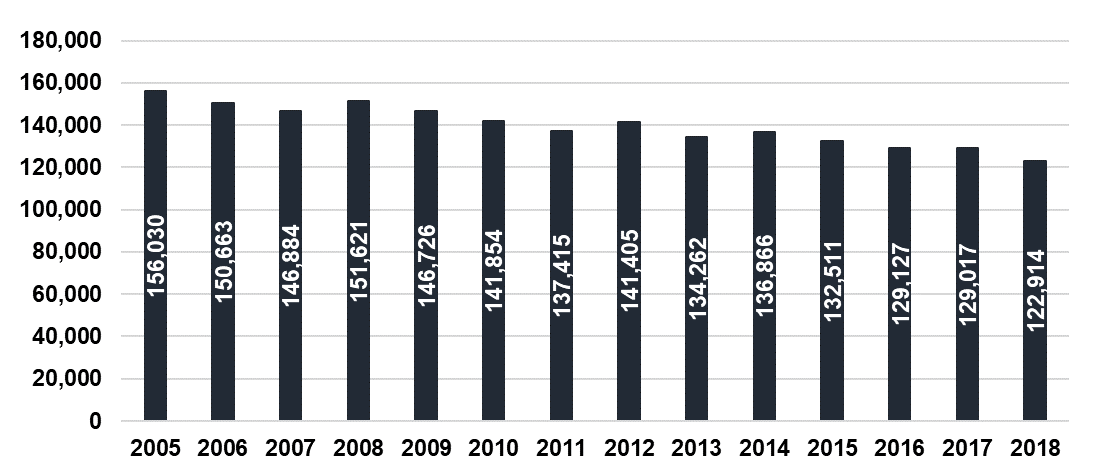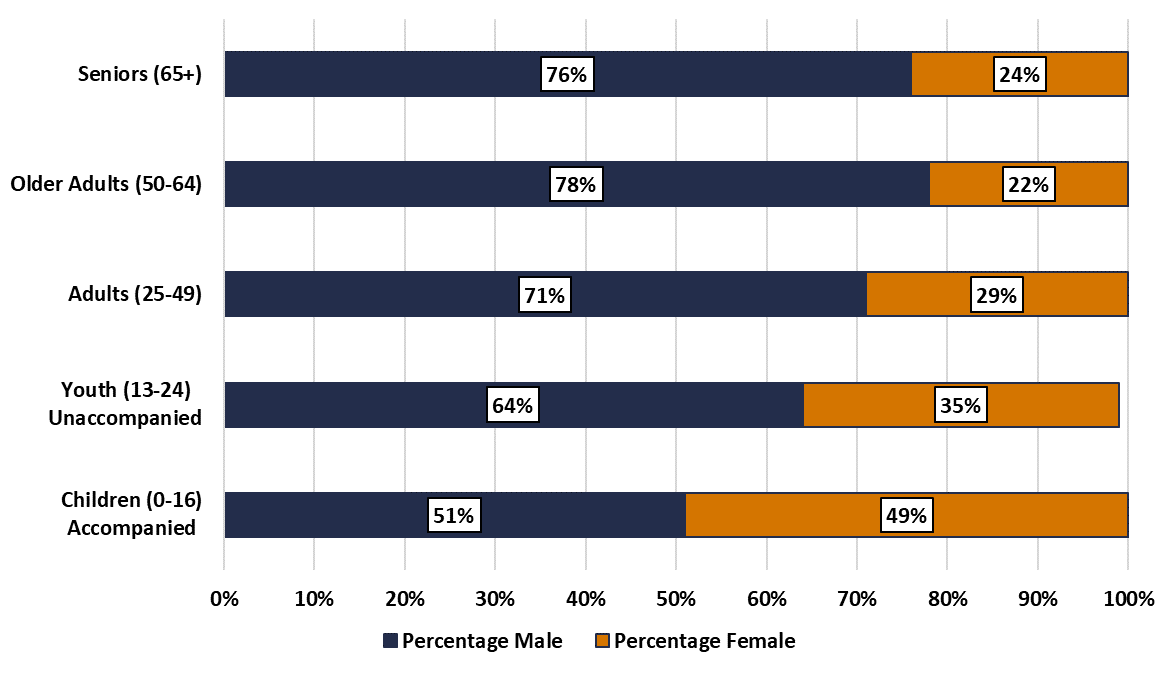Homelessness data snapshot: The National Shelter Study 2018 update
On this page
Introduction
The National Shelter Study (NSS) is an ongoing analysis of trends in homelessness shelter use in Canada. The NSS includes estimates of the number of emergency shelter users and their demographics. The study covers the period from 2005 to 2018. The NSS uses data collected by:
- the Homeless Individuals and Families Information System (HIFIS), and
- provincial and municipal partners that have data sharing agreements with the Government of Canada
Data
Data are from 223 emergency shelters across Canada, about half of all emergency shelters. The sample includes most of Canada’s largest shelters. The study sample is constitutes by 71% of the country’s total 15,620 emergency shelter beds in 2018. The study methods take into account people who use more than one shelter. Domestic violence shelters, temporary shelters and transitional housing do not participate in the National Shelter Study. For an in-depth description of the methods used for this study, refer to The National Shelter Study – Emergency Shelter Use in Canada (2005 – 2016).
Research findings
Extent of shelter use
In 2018, an estimated 123,000 people experienced homelessness at an emergency shelter. On an average night, there were approximately 15,000 people staying in shelters.Compared to 2017, there were 6000 fewer shelter users, and an estimated 21.2% decrease in the number of shelter users in 2005
Figure 1. Number of shelter users from 2005 to 2018

-
Figure 1. Number of shelter users from 2005 to 2018 Text version
Year Number of shelter users 2005 156,030 2006 150,663 2007 146,884 2008 151,621 2009 146,726 2010 141,854 2011 137,415 2012 141,405 2013 134,262 2014 136,866 2015 132,511 2016 129,127 2017 129,017 2018 122,914
Though the total number of shelter users has decreased gradually since 2005, demand for shelter beds is still high. This may be due to longer shelter stays. The proportion of people staying in shelter for 31 days and over has increased by 60% since 2005. The average nightly occupancy among all shelters in 2018 was 95.2%, with family shelters operating at 98.5% occupancy.
Figure 2. Occupancy rate by shelter type from 2005 to 2018

-
Figure 2. Occupancy rate by shelter type from 2005 to 2018 - Text version
Year Occupancy rate at youth shelter (in percentage) Occupancy rate at general shelter (in percentage ) Occupancy rate at family shelter (in percentage ) 2005 88.2 85.0 67.3 2006 72.9 85.6 70.0 2007 85.5 80.1 69.5 2008 85.5 85.7 85.4 2009 97.2 90.7 114.2 2010 77.3 85.4 76.3 2011 81.3 87.8 84.2 2012 87.8 92.8 89.8 2013 82.0 92.8 89.4 2014 83.3 94.9 86.3 2015 81.0 94.0 85.7 2016 85.5 92.9 84.6 2017 89.0 91.1 95.8 2018 85.7 95.6 98.5
Demographics
The age distribution of the shelter-using population remained stable from preceding years. The majority of shelter users were adults (55.5%, aged 25 to 49), followed by older adults (20.9%, aged 50 to 64) and youth (14.8%, aged 13 to 24). The average age among all shelter users was 40 years
The gender distribution of shelter users has not varied considerably since 2005. In 2018, 70.1% of shelter users were male, 29.2% were female, and 0.6% identified as a gender other than male or female
Figure 3. Gender distribution by age group in 2018

-
Figure 3. Gender distribution by age group in 2018 Text version
Age group Percentage male Percentage female 0 to 16 51 49 13 to 24 64 35 25 to 49 71 29 50 to 64 78 22 65+ 76 24
Indigenous peoples were overrepresented in Canada’s emergency shelters in 2018. Indigenous peoples make up 4.9% of the Canadian population according to the 2016 census. In contrast, 33.4% of shelter users identified as Indigenous.
An estimated 2,180 shelter users served in the military or the RCMP (1.8% of shelter users). This is a reduction from 2.3% in 2014. Among male shelters users, 2.1% were veterans, and among female shelter users, that proportion was 1.0%. The average age of a veteran shelter user was 48 years of age, compared to 39 for non-veteran shelter users.
The majority (87.9%) of shelter users were Canadian citizens. The number of refugees (0.9%) and refugee claimants (3.2%) in the shelter system increased since 2017. In 2017, 0.8% of shelters users were refugees and 2.3% were refugee claimants.
Figure 4. Proportion of shelter using population, and general population, by Indigenous status in 2018

-
Figure 4. Proportion of shelter using population, and general population, by Indigenous status in 2018 Text version
Population status Canadian population in 2016 census (in percentage) Shelter users in 2018 (in percentage) Indigenous 5 33 Non-indigenous 95 67
Chronic homelessness among shelter users
In 2018, data from a subset of 21 communities were used to estimate chronic homelessness in Canada. The communities ranged in population size from less than 50,000 to over 1,000,000 The sample included 63,431 shelter users, accounting for over half of the total estimated shelter users for 2018. Shelter users are considered chronically homeless if they experienced homelessness in emergency shelters, and:
- used a shelter for 6 months (180 days) or more in the past year, and/or
- had shelter stays in each of the last 3 years
In 2018, 22.3% of shelter users in the sample met the criteria for experiencing chronic homelessness. At the national level, an estimated 27,500 shelter users experienced chronic homelessness in 2018, which was fewer than in 2017 (28,900).
Key findings
- The number of people accessing emergency shelter decreased in 2018 but demand for shelter beds remained high
- The majority of shelter users were adults, and were predominantly male. The average age of shelter users was 40 years
- Indigenous peoples were overrepresented among shelter users
- The proportion of shelter users who identified as refugees and refugee claimants increased in 2018
- An estimated 27,500 shelter users experienced chronic homelessness in 2018
Contact us
To find out more about homelessness research, visit the Data analysis, reports and publications page.
If you have any questions about this report, contact us by email.
Report a problem on this page
- Date modified: